Exercises (2266)
volleyball
Games / Tournament
Game idea:
Two teams face each other on the volleyball court and play the ball over the net so that it falls to the ground in the opponent's court.
Score:
A point is scored if the ball lands in the opponent's court or the opposing team is unable to return the ball in accordance with the rules.
Court:
Volleyball court (9m x 18m) divided in the middle by a net. Net height 2.00m to 2.42m depending on the category.
Number of participants:
6 against 6
Rules of the game:
The serve is executed behind the baseline by the team that won the last point or has the right to serve and must be hit directly over the net to the other side. If the ball is in play, the team in possession of the ball has the right to hit the ball three times (plus block contact) to return the ball to the opponent's half of the court. The ball may not be caught or guided and may not be touched twice in succession by a single player. The ball may be played with any part of the body (exception: at the face-off). The net may not be touched by the players at the upper white band. The move lasts until the ball touches the ground, goes out of bounds or a team fails to return it properly.
If the right to play the ball is regained by scoring a point, the players change positions in a clockwise direction. A set goes to 25 points with a difference of at least 2 points, otherwise the game continues until a 2-point lead has been established. If a team can win 3 sets, the game is won.
Volleyball: Ball over the string
Forms of play / exercises
2 teams of 3-6 players
Game over the net with 2 teams of 3-6 players. The ball may be caught and is then thrown from the bottom to the top over the net into the opposing team's half of the pitch (no passing allowed within your own team). After each throw, the thrower runs around one of the cones, which are placed 1-2 metres outside the playing area. Each side has one cone next to the sideline and one behind the baseline. The opposing team catches the ball before it falls to the ground and then throws it back. Points for: Ball touches the ground, ball leaves the court, ball lands in the net.
Variant:
After a catch ball, 3 passes are allowed within the own team.
Pitch:
1 volleyball
1 volleyball net
6 cones
Volleyball: ball over the line combined with technique training
Forms of play / exercises
Group work
From the game of "ball over the string" to the game of "volleyball": The aim is to familiarise participants with the game of volleyball using simple game and exercise forms. The series of exercises is intended to help create more flow in the game of volleyball, which results in more fun than if the game consists almost exclusively of passing and errors.
1. Ball over the line:
Ball may be caught. Throw the ball over the net (only throws from bottom to top are allowed). After each throw, run around one of the cones, which are placed 1-2 metres outside the playing field. Each side has one cone next to the sideline and one behind the baseline. The opposing team catches the ball before it falls to the ground and then throws it back (no passes within the team). Points for: Ball touches the ground, ball leaves the court, ball lands in the net. Additional rule for better flow of play: the ball must be thrown into the back zone (over the 3 metre line).
2. Technique training: Manchette:
Demonstration by the sports leader (key points). Then practise in groups of 2 (at least 10 passes each)
3. Ball over the line combined with a cuff:
Same form of play as described above, but now the first touch of the ball after the opponent's throw over the net is with a cuff. After the cuff, the ball is caught by a team member and thrown to the opposite side. The run around the thrower's cones can still be maintained to create more free spaces (optionally, the passer must also perform the additional loop) or the rule can be omitted.
4. Technique training: 10-finger pass:
Demonstration by the sports leader (key points). Then practise in groups of 2 (at least 10 passes each)
5. Ball over the line combined with manchette and 10-finger pass:
Same game form as above. The first touch of the ball after the throw over the net is again with a cuff. The second touch of the ball must now be a 10-finger pass to a team-mate. Only then is the ball caught and thrown to the opposite side. The rule with the rounding of the cones can be retained (for throwers and passers) or cancelled.
6 cones
Per group:
1 volleyball
Volleyball: Cuff - alone
Forms of play / exercises
Individual work
After a brief instruction from the sports leader on the manchette (stretched arms, impulse from the legs), the participants perform the following exercises:
- Pass the ball up with the manchette, drop it on the floor, run under it, pass the ball up with the manchette.
- Manchette - drop the ball on the floor - top pass - drop the ball on the floor - manchette - drop the ball on the floor - top pass, etc.
- Manchette - top pass (to the wall) - manchette - top pass (to the wall), etc.
Pro Tn:
1 Volleyball
Volleyball: Manchette - Conveyor belt
Forms of play / exercises
Group work
Half of the tn (red) line up sideways on a line about 1-2 metres apart. The other half of the Tn (blue), equipped with a volleyball, line up in a column of one at a distance of 2-3 metres from the front Tn of the first group. The teammates in the blue group now play a handball one after the other to the first teammate in the red group, who plays the ball straight back using the handball. After each pass, the teammates in the blue group move by one until they have completed the whole row. They then join up again at the front. Switch groups
.Per group of 2:
1 volleyball
Volleyball: Manchette - for two
Forms of play / exercises
Partner work
After a short instruction by the sports leader on the cuff (stretched arms, impulse from the legs), the participants carry out the following exercises:
- A passes (throws) the ball to B from below, B passes back with the cuff, A catches the ball and throws it back again - switch tasks.
- Free passing in pairs - use upper passes and cuffs adapted to the situation.
Per group of 2:
1 volleyball
Volleyball: Upper pass - alone
Forms of play / exercises
Individual work
After a short instruction by the sports leader on the top pass, the participants perform the following exercises:
- Bounce the ball on the floor with both hands, run underneath it - catch the ball above your head with both hands;
- Ditto, but pass the ball straight back up, 1x on the floor - pass it up - 1x on the floor, etc.
- Juggle the ball (own top pass)
Juggling the ball, go to a basketball hoop and score a basket there with the volleyball (top pass); then change the basket.
Pro Tn:
1 volleyball
3-6 basketball hoops
Volleyball: Upper pass - conveyor belt
Forms of play / exercises
Group work
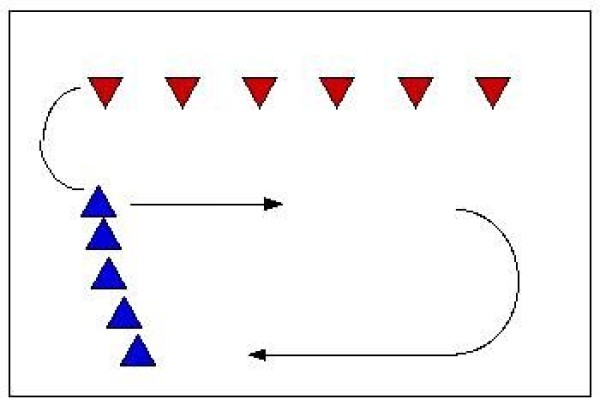
Half of the tn (red) line up sideways on a line about 1-2 metres apart. The other half of the teammates (blue), equipped with a volleyball, line up in a column of one at a distance of 2-3 metres from the front teammate of the first group. The teammates in the blue group now play an upward pass one after the other to the first teammate in the red group, who plays the ball straight back using the upward pass. After each pass, the teammates in the blue group move by one until they have completed the whole row. They then join up again at the front. Switch groups
.Per group of 2:
1 volleyball
Volleyball: Upper pass - in pairs
Forms of play / exercises
Partner work
After a brief instruction from the sports leader on the top pass, the participants perform the following exercises in teams of two:
- Throw the volleyball to each other inaccurately (too short, too long, etc.) Partner must catch the ball over their head before it falls to the floor.
- Pass the ball to each other with the top pass; in between, pass the ball to yourself once each time.
- Top pass to partner A, partner A passes the ball up to himself several times (juggling) while B quickly touches A's shoes and returns to his place. Now he receives an upper pass and must juggle the ball until A has touched his shoes, etc.
- Direct upper pass in pairs. Play together with the most accurate passes possible.
Per group of 2:
1 volleyball
Weapons range orienteering
Orienteering
Single run or 2/3 groups
Posts (some of which are fixed) are distributed around the weapons range, which the participants approach individually or in small groups with/without a map. The Waffenplatz orienteering run is particularly suitable for familiarising participants with the terrain (practice form), but can also be carried out as a competition form.
There are various options for carrying out the orienteering run:
- Line run:
The posts are approached in numerical order using a map. To ensure that not all participants run in the same direction at the start, the first control is marked on the orienteering map. - Numbered run:
According to the 1st marked control, all even or odd controls are approached using a map. Depending on the time conditions, the 3-way rule could also be an option. - Memory run:
A poster with all the marked controls is displayed at the start. The participants memorise a route and try to collect the controls. Depending on how many posts the participants can memorise, they have to return to the starting position sooner or later to take another look at the map. - Filling station run:
A poster with all the posts is displayed at the start and at some posts. After the start, each participant orientates themselves at the "petrol stations" about the control locations. - Star run:
The start forms the centre of the run. Each control is approached individually (in a star shape) (variant: clockwise or anti-clockwise). After each control, the runners return to the centre before moving on to the next control (if necessary, have the controls checked by the sports director). The controls can be approached using a map or the runners must memorise the route using a poster (cf. memory run).
Variant:
Run in groups of 2 (3). The person in front holds the map (except for the memory run) and runs to the next control. The person behind observes the running behaviour of the person in front and gives feedback on the running style. The roles are swapped at each control point. Of course, this form of exercise requires a prior introduction to the topic of running style analysis by the sports leader.
Orienteering posts (permanently mounted, but always checked, or for unplugging)
2-3 Wpl-OL posters (only necessary for memory, petrol station and possibly star run)
1 stopwatch
Participant/group:
1 orienteering map (prepared in advance by sports director)
1 running map form 30.063
(depending on the variant, e.g. line and number run, mark the first controls on the different running maps beforehand)
Variation of the exercise:
1 poster "Running error pictures"
Wall Drill 2 (Switch)
Power
Individual work
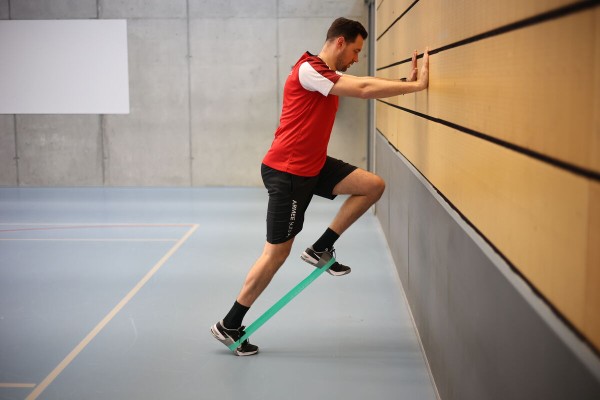
Wall Drill 3 (Double Switch)
Power
Individual work
Wall Drill 4 (Continuous Switch)
Power
Individual work
Wall Jump (360 degrees)
Parkour
Individual work
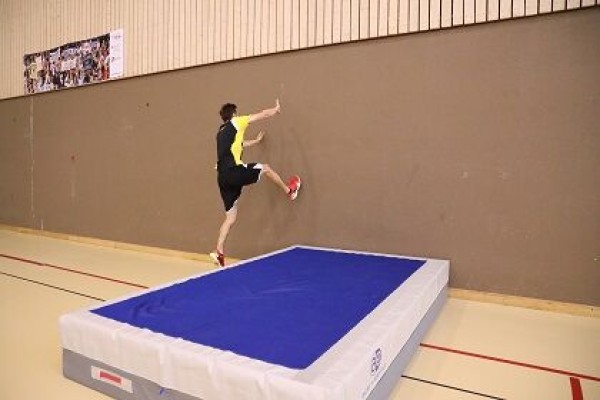
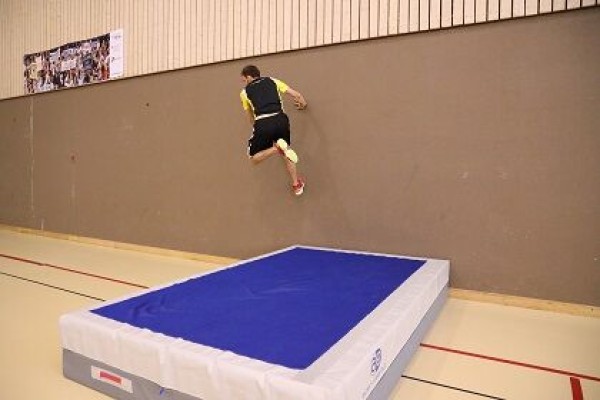
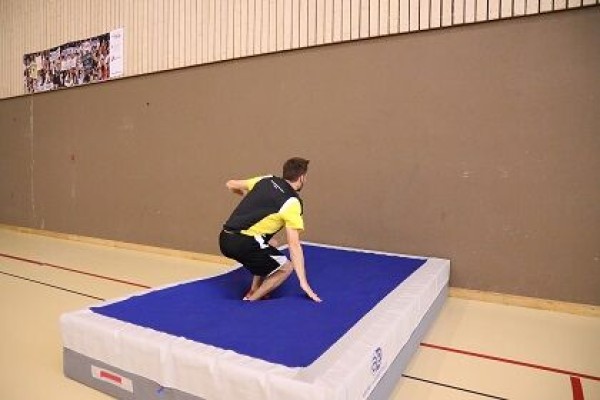
Approach at a 45 degree angle to the wall, jump high against the wall, push off with one or both feet on the wall, (360 degree) turn (over the shoulder facing away from the mat ► indoor variant), two-legged landing.
Variants:
Landing with roll;
540 degree turn in the air.
1 wall
1 soft mat (large) ►Indoor version
Indoor post setup:
Place a large soft mat on a wall.
Wall Run I
Parkour
Individual work
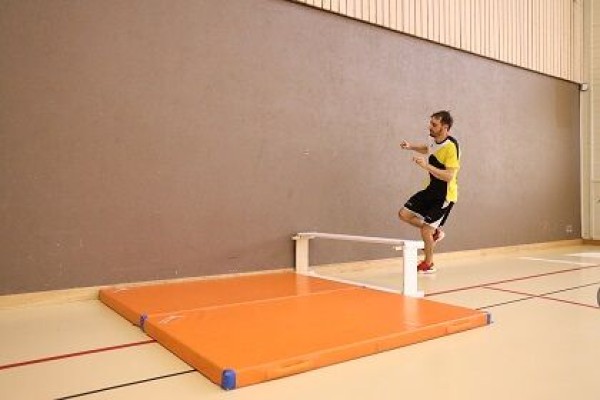

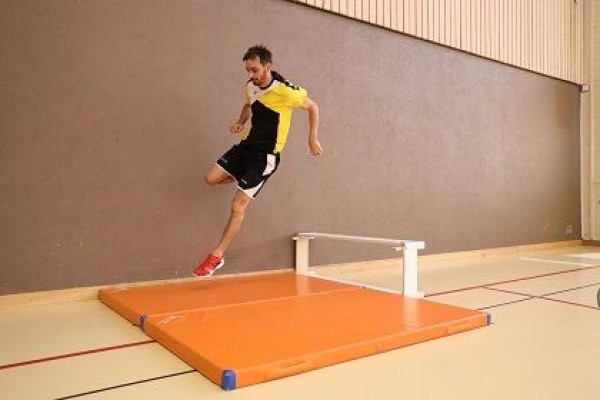
Approach at a 45 degree angle, jump off the obstacle (vaulting box element ► indoor version) with the leg facing away from the wall and push off from the wall with the leg facing the wall for a safe landing (on the soft mat ► indoor version).
Make it easier:
To improve the grip on the wall, a small soft mat can be set up at the point of contact with the wall from which the participants can push off.
Variant:
Higher obstacle (if necessary, support yourself with your hand on the obstacle as an aid).
1 vaulting box element ► indoor version
1 soft mat (small) ► indoor version
1 wall
Indoor post setup:
Place a vaulting box element on a wall (long edge pointing upwards), place a soft mat behind it.
Outdoor:
Place an obstacle (or participant) on a wall.
Wall Run II
Parkour
Individual work
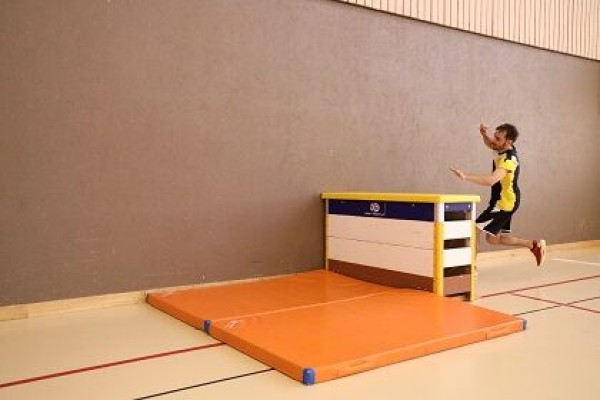
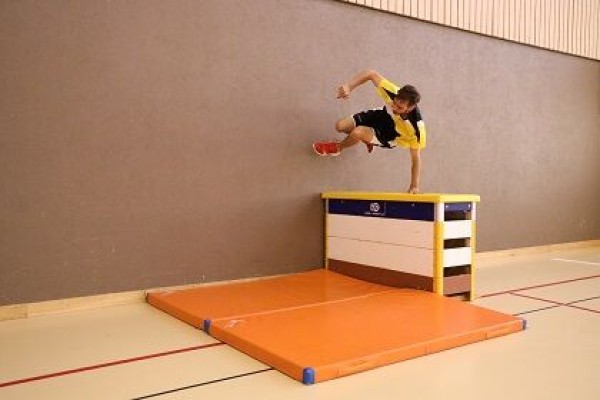
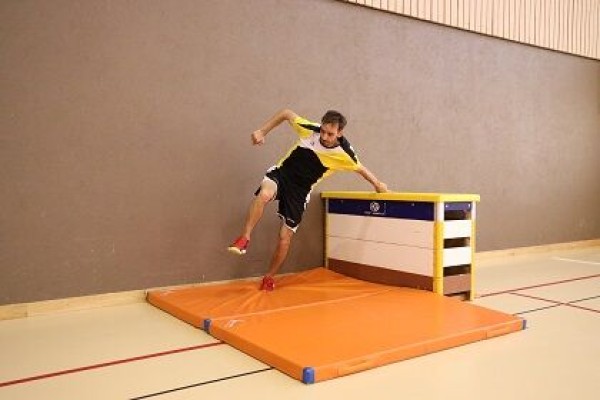
Approach at a 45 degree angle, jump off in front of the vaulting box with the leg facing away from the wall and push off from the wall over the box with the leg facing the wall, landing on the soft mat.
Make it easier:
To improve the grip on the wall, a small soft mat can be set up at the point of contact with the wall from which the participant can push off.
Variant I:
After the jump, support yourself on the vaulting box with the hand facing away from the wall. Walk over the vaulting box with your feet.
Variant II:
After the jump, support yourself on the vaulting box with your hand facing away from the wall. Walk along the wall with your feet.
1 swing box
1 soft mat (small)
1 wall
Post structure:
Place the swing box (4 elements incl. top section) against a wall, place a soft mat behind it.
Wall Run III
Parkour
Individual work
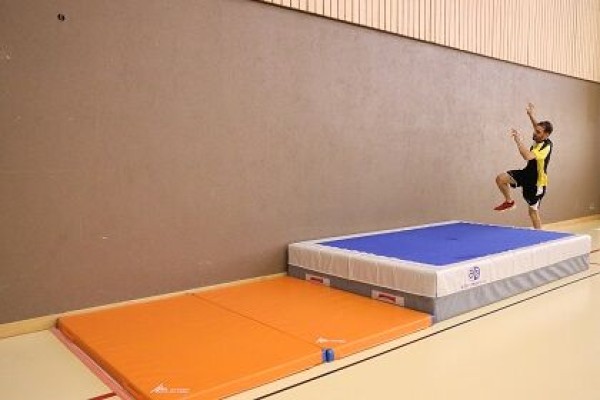
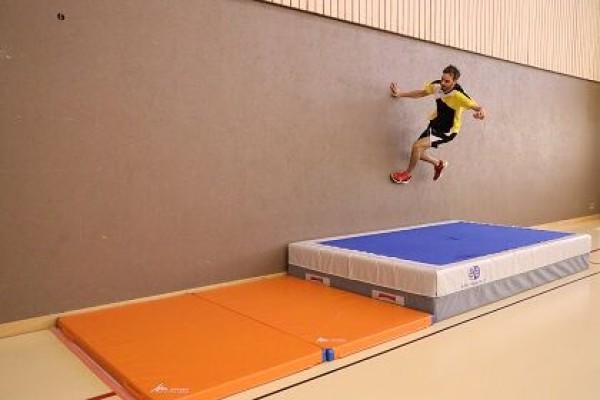

Approach at a 45-degree angle to the wall, jump off with the leg facing away from the wall (in front of the large soft mat ► indoor version), take as many steps as possible against the wall, then push off strongly to land (on the small soft mats ► indoor version).
1 soft mat (large) ► indoor version
2 soft mats (small) ► indoor version
1 wall
Indoor post setup:
Place a large soft mat (lengthwise) on the hall wall, behind it place two small soft mats.
outdoor:
One wall (with grass surface if possible)
Wall Run IV
Parkour
Individual work
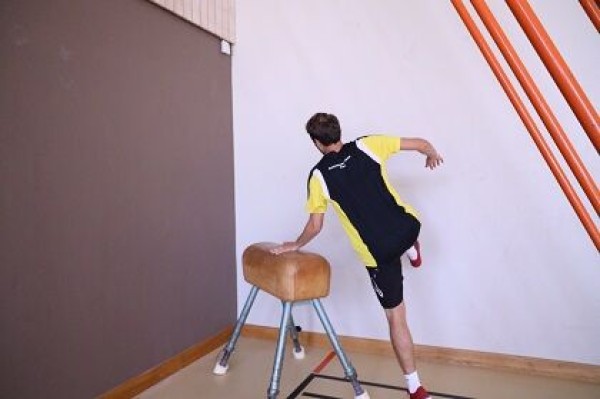
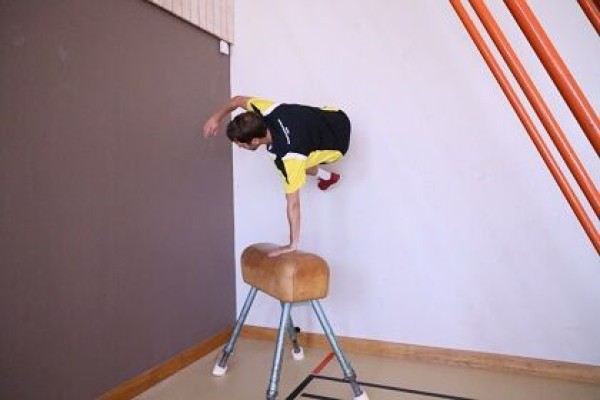
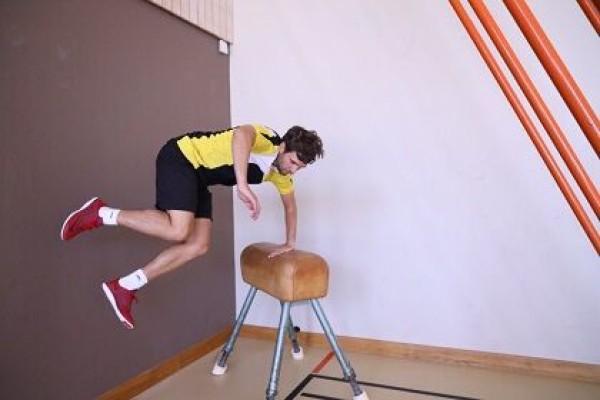
Approach at a 45 degree angle, jump off with the leg facing the wall, the hand facing away from the wall turned forwards (fingers pointing away from the wall), support on the horse, run over both walls (2 steps on the first wall, 1 step on the second wall), jump into the standing position.
1 pommel horse
1 wall corner
Post setup:
Place the pommel horse in a corner of two walls.
Alternating jump on an object
Power
Individual work
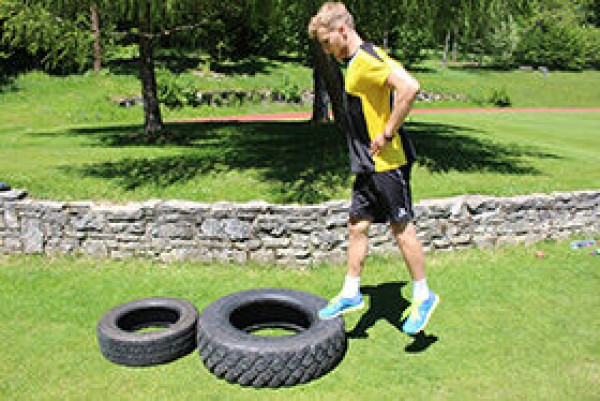

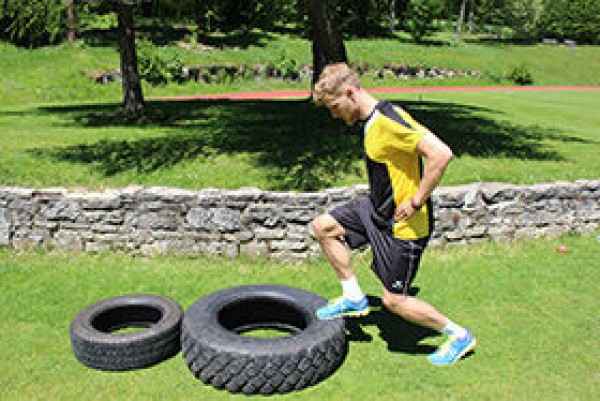
Stand with one leg on the tyre and one on the floor, alternating the foot position as you jump.
Attention:
Keep your upper body upright, cushion your landing.
Lighten:
Start the exercise standing in front of the object, alternating one foot on the object and back to the starting position (no jumps - similar to climbing stairs); choose a lower element; lower cadence.
Harden:
Higher cadence; additional weight (on the feet); jump on the tyre (helmet) upwards to change legs.
1 tyre (10DM)
1 tyre (DURO)/helmet ► Make the exercise easier
2 weight cuffs/1 weight waistcoat ► Make the exercise more difficult (additional weight)
Alternating jump on an object
Power
Individual work
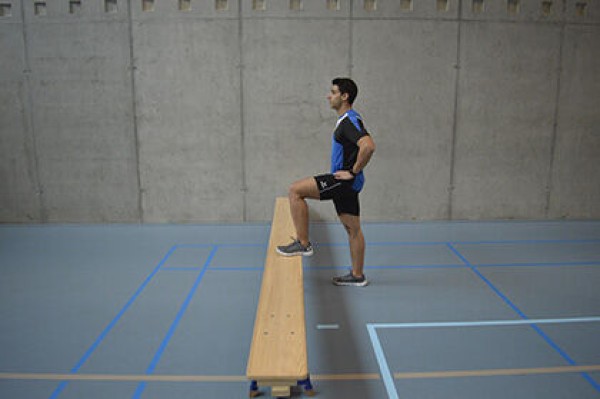
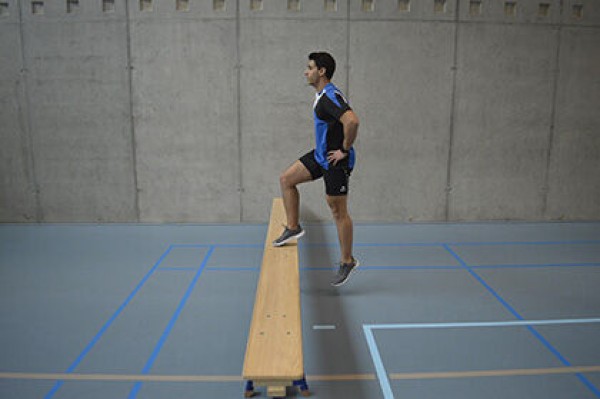
Stand with one leg on the long bench/swinging box top and the other leg on the floor. Alternate the foot position during the jump.
Caution:
Keep your upper body upright, cushion the landing.
Lighten:
Start the exercise standing in front of the element, alternating one foot on the object and back to the starting position (no jumps); choose a lower element; lower cadence.
Harden:
Select a higher element; higher cadence; additional weight (on the feet); jump on the element to change legs.
1 long bench
1 vaulting box top section ► Easier exercise (position)
2 vaulting box elements (incl. top section) ► More difficult exercise (position)
2 weight cuffs/1 weight waistcoat ► More difficult exercise (additional weight)
Competition
Obstacle course in the hall
The obstacle course in the hall is set up in the specified standard size (volleyball court). All participants complete at least two runs for time (competition format according to technical instructions). Depending on the time conditions, additional runs may be guaranteed (voluntary).
11 stakes
10 soft mats (small)
1 soft mat (large)
3 vaulting boxes
3 long benches
1 parallel bars
2 horses
2-3 stopwatches
1 competition sheet (for noting down times)
1 flipchart (optional for noting down times)
Competition
Obstacle course in the terrain
All participants will complete at least one timed run (competition format in accordance with the technical instructions). Depending on the time conditions, additional runs may be guaranteed (voluntary).
2-3 stopwatches
1 evaluation sheet (to record the times)
1 flipchart (optional for recording the times)
Obstacle course in the terrain
Before each use of the HiBa terrain, the elements must be checked for their suitability and the course must be cleaned/cleared of foreign objects. Minimising the risk of injury (e.g. avenging gravel pits on the climbing wall) is the responsibility of the sports manager and has top priority
Wippen ► bouncen
Coordination exercises
Individual work
Bob up and down on a slightly longer, tautly stretched slackline.
Ease:
Bob/bounce less intensively; help a partner by holding their hand (always go with the balancing movement and only stabilise if the slackliner is about to fall).
Easthen:
Walk at the same time and bob/bounce with every step.
1 Slackline
Dice relay
Forms of play / exercises
Group work
4-5 participants per group
A runner runs to a turning point (e.g. colouring stick, marker cone or cone) or to the wall of the hall to throw a show dice. The result of the number rolled multiplied by four corresponds to the number of jumps that must be performed with the skipping rope (max. 24x, min. 4x) before running back to the group. Which group finishes first (each participant runs once)?
Replacement: Run around the group, shake hands and send the next runner onto the course.
Per group:
2 colouring sticks
1 foam cube
1 skipping rope
Throwing body (howler): Target throw
Forms of play / exercises
Group work

One participant defines a target zone (e.g. target zones divided with skipping ropes in a handball goal -> 3 colours with top-middle-bottom). The entire group then tries to hit the specific target (e.g. yellow-bottom) by throwing the howler (3 attempts per participant from a specific line).
Additional strengthening task:
Those who have not scored a hit complete a strength exercise: 20x jumping jacks
1 handball goal
6-8 skipping ropes (demarcate target zones)
3 marking tapes (define target zones using colours)
3 throwing objects (howlers)